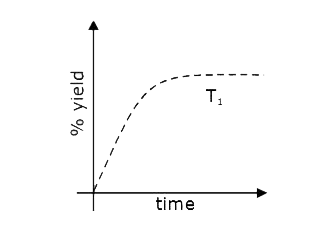Dinitrogen and dihydrogen react with each other to produce ammonia according to the following chemical equation:
N2(g)+3H2(g)→2NH3(g)
a. Calculate the mass of ammonia produced if 2.00×103g dinitrogen reacts with 1.00×103g of dihydrogen.
b. Will any of the two reactants remain unreacted?
c. If yes, which one and what would be its mass?
The correct Answer is:(i) 2.43×103g (ii)yes
(iii) Hydrogen will remain unreacted ; 5.72×102 g
(i) Balancing the given chemical equation,
N2(g)+3H2(g)→2NH3(g)
From the equation , 1 mole (28 g )of dinitrogen reacts with 3 mole (6 g) of dihydrogen to Give 2 mole (34 g) of ammonia .
⇒2.00×103 g of dinitrogen will react with 6g28g×2.00×103g dihydrogen i.e .,
2.00×103 g dinitrogen will dinitrogen will react with 428.6 g of dihydrogen .
Given ,
amount of dihydrogen =1.00×103g
Hence ,N2 is the limiting reagent .
∴ 28 g of N2 prouces 35 g of NH3
Hence , mass of ammoina produced by 2000 g of N2=34g28g×2000g
=2428.57 g
(ii) N2 is the limiting reagent and H2 is the excess reagent .Hence ,H2 will remain unreacted.
(ii) Mass of dihydrogen left unreacted =1.00×103g−428.6g
=571.4 g
Topper's Solved these Questions
Similar Questions
Dinitrogen and dihydrogen react with each other to produce ammonia according to the following chemical equation:
N2(g)+3H2(g)→2NH3(g)
a. Calculate the mass of ammonia produced if 2.00×103g dinitrogen reacts with 1.00×103g of dihydrogen.
b. Will any of the two reactants remain unreacted?
c. If yes, which one and what would be its mass?View SolutionDinitrogen and dihydrogen react with each other to produce ammonia according to the following equation : N2(g)+3H2(g)→2NH3(g)
(i) Calculate the mass of ammonia produced if 2.00×103 g dinitrogen react with 1.00×103 g of dihydrogen.
(ii) Will any of the two reactants remain unreacted?
(iii) If yes, which one and what would be its mass?View Solution
Knowledge Check
- Question 1 - Select One
Which of the following is correct for the reaction? N2(g)+3H2(g)→2NH3(g)
AKP=KcBKP<KcCKP>KcDPressure is required to predict the correlation - Question 2 - Select One
The % yield of ammonia as a function of time in the reaction N2(g)+3H2(g)⇔2NH3(g),(g)ΔH<0 at (P,T1) is given below
 A
A B
B C
C D
D
- Question 3 - Select One
Which one of the following equation is correct forr the reaction : N2(g)+3H2(g)→2NH3(g) ?
A3d[H2]dt=2d[N2]dtB2d[N2]dt=13d[H2]dtC2d[NH3]dt=−3[H2]dtD3d[NH3]dt=−2d[H2]dt
Which of the following is correct for the reaction? N2(g)+3H2(g)→2NH3(g)
View Solution3.00 g of H2 react with 28.00 g of O2 to yield H2O.
Calculate the mass of one of the reactants which remains unreacted.View Solution3.0 g of H2 reacts with 29.0 g of O2 to yield H2O.
Calculate the amount of one of the reactants which remains unreacted.View SolutionWhich one of the following equation is correct for the reaction, N2(g)+3H2(g)→2NH3(g)?
View SolutionThe commercial poduction of ammonia is represented by the equation,
N2(g)+3H2(g)→2NH3(g).
If the rate of disappearance of H2(g) is 1.2×10−3 mol/min, what is the rate of appearance of NH3(g)?View Solution
